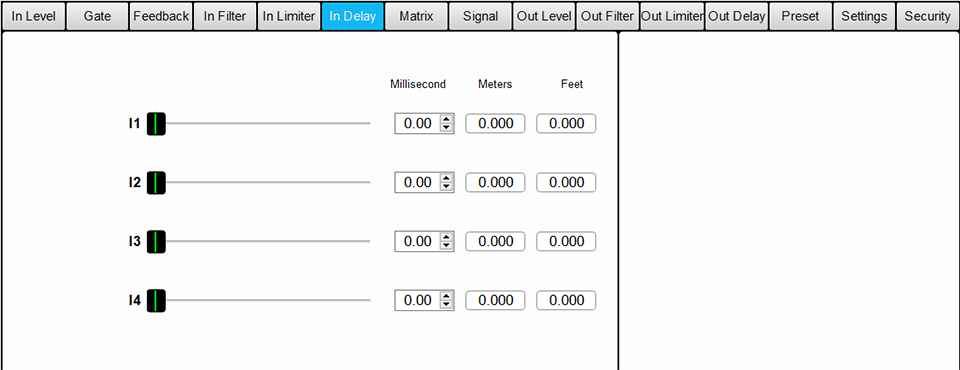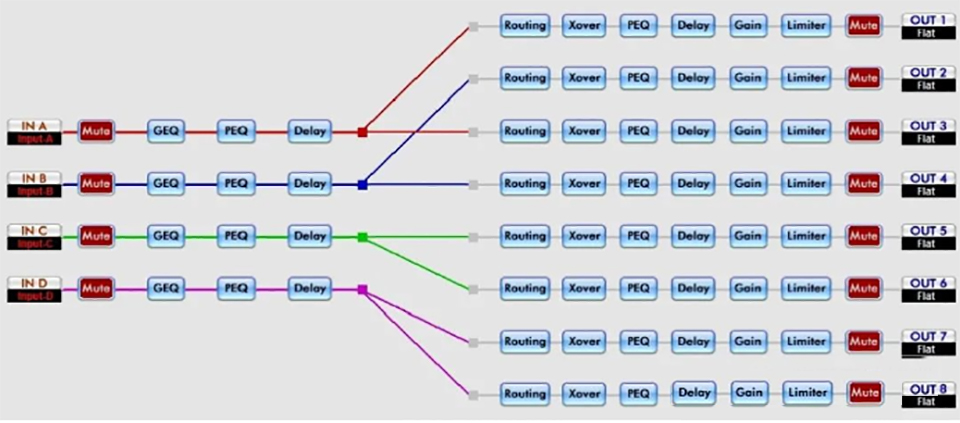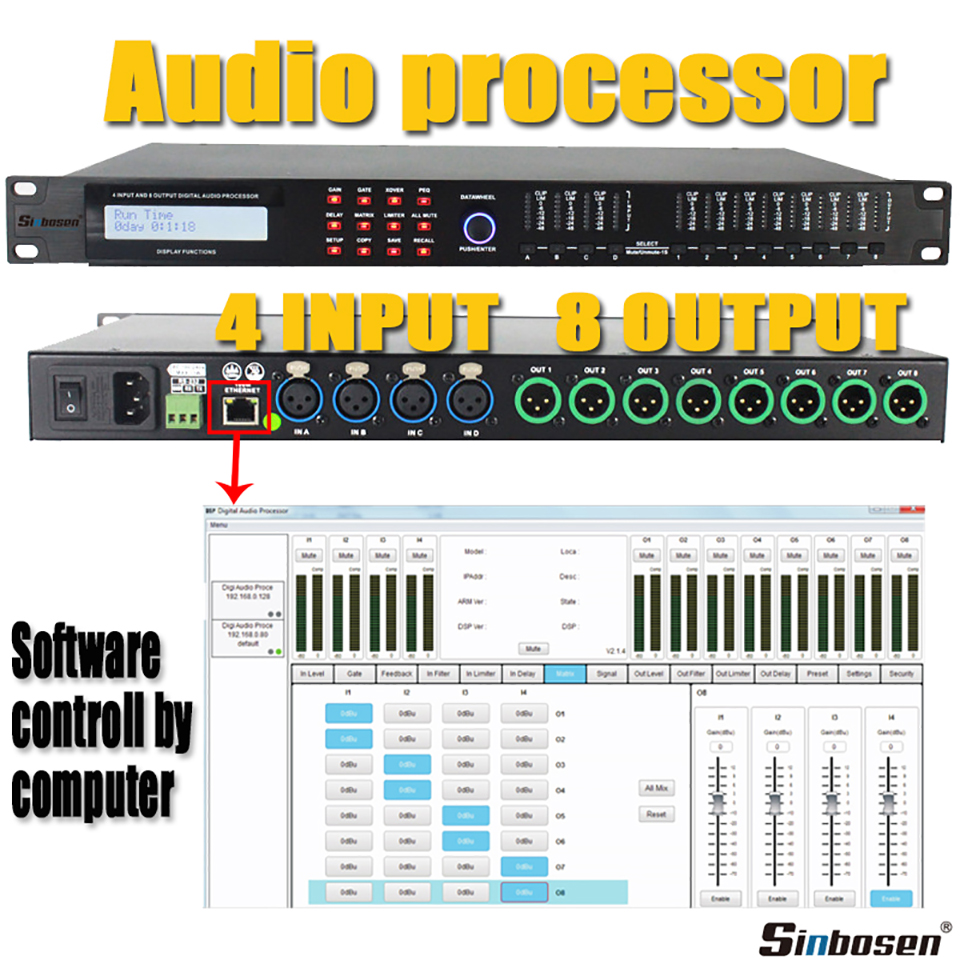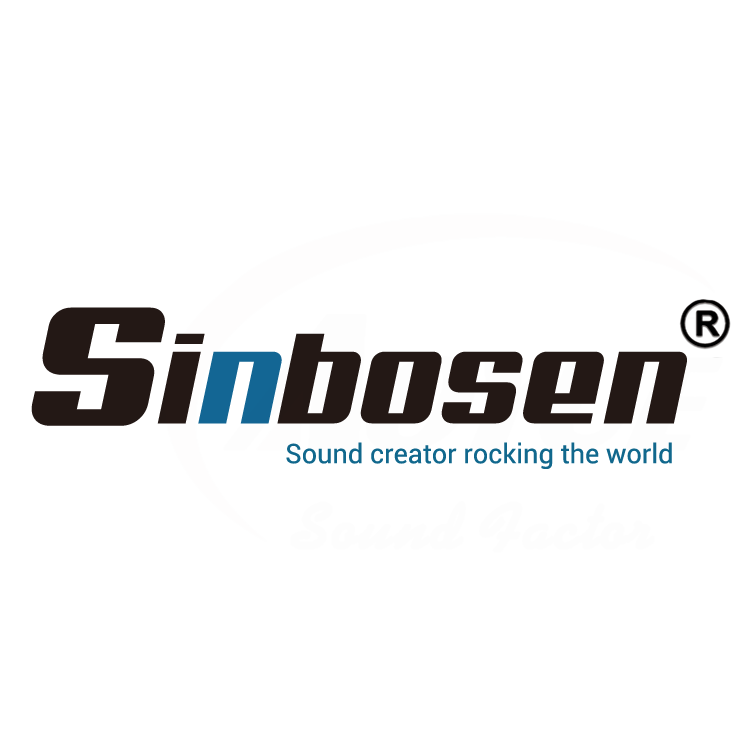Digital audio processors basic function to introduction
Views : 11748
Update time : 2022-03-28 16:38:52
A digital audio processor (DSP) is an indispensable and important device in a sound reinforcement system. It is mainly used to adjust and control the working state of power amplifiers and speakers, and improve the objective technical performance of the entire system, such as safety and reductibility.
There are multiple input (IN) and output (OUT) channels in the digital audio processor, and each channel is configured with many different types of device functions. Also available in English.

What problems do the corresponding functions in these blocks use to solve? Friends who are not familiar with audio may be confused, and they will be confused when they look at it.
The functional structure of the digital audio processor is divided into input channel part and output channel part. Common products generally have 2-4 input channels and 4-8 output channels,such as Sinbosen have 2 input 6 output processor and 4 input 8 output processor

For example, the current picture is a product with 4 input channels and 8 output channels, which is generally called a 4-in 8-out processor.
The related functions are introduced below.
The functions in a digital audio processor are distributed among input and output channels.
First of all, between the input and output channels, there is a function of signal distribution, that is, the function of routing (the line in the figure), which is used to set and assign the signal of an input channel to a specified output channel.

Or think which input channel the signal used to set a certain output channel comes from.

As shown in the figure above, in the OUT 1 channel, click the Routing icon, open the page, and select A, which means that the signal of the OUT 1 output channel comes from the IN A input, or indicates that the signal of the IN A input channel is assigned to the OUT 1 output aisle.
In this way, you can set specific channels in the processor to control the corresponding speakers according to the type of speakers you have (full range or subwoofer) or position (main or fill).
For example:
The two input channels of the processors IN A and IN B are connected to the L and R main output channels of the mixer. The processors OUT1 and OUT2 control the full-range speakers of the left and right channels of the main sound reinforcement, and the processors OUT3 and OUT4 control the left and right sound of the main sound reinforcement. channel subwoofer.
The IN C input of the processor is connected to the AUX1 output of the mixer, and OUT5 and OUT6 respectively control the left and right monitor speakers.
The IN D input of the processor is connected to the GROUP 1 output of the mixer, OUT7 and OUT8 control the left and right fill speakers, and the signal routing can be set as shown below.

In addition, general processors can set the channel names according to their own habits, which is convenient for their own identification and adjustment.
For example, if IN A is named Main L, you know that this channel is connected to the left channel of the main output of the mixer.
OUT 1 is named FR L, which means to control the full-range speaker on the left of the main PA, and SUB L is the subwoofer on the left.

Next, we introduce other functions in the digital audio processor.

In the output channel of the digital audio processor, in addition to the above-mentioned signal distribution function (Routing), there are Xover, PEQ, Delay, Limiter, Gain, Mute functions, these functions are mainly aimed at the working state of the speaker, including safety and restoration. and other objective indicators for adjustment and control.
1.Xover: the frequency division function, which is used to set the frequency range of the electrical signal output by this output channel, and cooperate with the speaker used to make the speaker perform fully, eliminate potential safety hazards, and improve the long-term work safety of the speaker.
Among them: high pass (low cut) is used to set the lower limit frequency of the output signal, and low pass (high cut) is used to set the upper limit frequency of the output signal.
There is also a choice of crossover mode (filter type) and crossover slope to make the performance of the speaker better.
2.PEQ: Parametric equalizer, the equalizer configured in the output channel of the digital audio processor, is mainly used to adjust the frequency response characteristics of the speaker, eliminate the frequency response defects of the speaker itself, reduce distortion, and improve the degree of restoration.
Frequency: used to select the center frequency or starting frequency of the frequency band to be adjusted
Q value: bandwidth: used to adjust the size of the control range of this section of equalization
Gain: for boosting or attenuating
Filter Type: There are many options
PEQ: used to adjust the frequency band centered on the select frequency
LowShelf: used to adjust the frequency band below the select frequency
HighShelf: used to adjust the frequency band above the select frequency
Allpass: All-pass filter, used to adjust the phase characteristics of the select frequency
Bandpass: Bandpass filter for making adjustments to the select frequency band
Notch: A notch filter that performs a narrow and deep attenuation on the select frequency point
Lowpass VarQ: Lowpass for variable Q value
Highpass VarQ: Highpass for variable Q value
3.Delay: It is used to set how long the output signal of this channel is delayed to send out. It is used to synchronously correct the sound asynchrony between the speaker and the speaker or between the different speaker units in the external frequency divider speaker. Restorative.
4. Gain: Adjust the intensity of the output signal of this channel, which is used to adjust the volume balance between speakers of different channels or different speakers in the same external frequency division speaker.
The gain value is 0, the signal size is not adjusted, the gain value is positive, the signal is amplified; the gain value is negative, the signal is attenuated.
The "phase" is used to adjust the signal polarity of this output channel, and adjust the phase of speakers that may have different phases to be consistent.
5.Limiter: It is used to limit the maximum value of the output signal size of this channel to prevent the output signal from being too large and causing the rear power amplifier to distort and burn the speakers in the speaker.
6. Mute: used to close/open this signal channel

There are multiple input (IN) and output (OUT) channels in the digital audio processor, and each channel is configured with many different types of device functions. Also available in English.

What problems do the corresponding functions in these blocks use to solve? Friends who are not familiar with audio may be confused, and they will be confused when they look at it.
The functional structure of the digital audio processor is divided into input channel part and output channel part. Common products generally have 2-4 input channels and 4-8 output channels,such as Sinbosen have 2 input 6 output processor and 4 input 8 output processor

For example, the current picture is a product with 4 input channels and 8 output channels, which is generally called a 4-in 8-out processor.
The related functions are introduced below.
The functions in a digital audio processor are distributed among input and output channels.
First of all, between the input and output channels, there is a function of signal distribution, that is, the function of routing (the line in the figure), which is used to set and assign the signal of an input channel to a specified output channel.

Or think which input channel the signal used to set a certain output channel comes from.

As shown in the figure above, in the OUT 1 channel, click the Routing icon, open the page, and select A, which means that the signal of the OUT 1 output channel comes from the IN A input, or indicates that the signal of the IN A input channel is assigned to the OUT 1 output aisle.
In this way, you can set specific channels in the processor to control the corresponding speakers according to the type of speakers you have (full range or subwoofer) or position (main or fill).
For example:
The two input channels of the processors IN A and IN B are connected to the L and R main output channels of the mixer. The processors OUT1 and OUT2 control the full-range speakers of the left and right channels of the main sound reinforcement, and the processors OUT3 and OUT4 control the left and right sound of the main sound reinforcement. channel subwoofer.
The IN C input of the processor is connected to the AUX1 output of the mixer, and OUT5 and OUT6 respectively control the left and right monitor speakers.
The IN D input of the processor is connected to the GROUP 1 output of the mixer, OUT7 and OUT8 control the left and right fill speakers, and the signal routing can be set as shown below.

In addition, general processors can set the channel names according to their own habits, which is convenient for their own identification and adjustment.
For example, if IN A is named Main L, you know that this channel is connected to the left channel of the main output of the mixer.
OUT 1 is named FR L, which means to control the full-range speaker on the left of the main PA, and SUB L is the subwoofer on the left.

Next, we introduce other functions in the digital audio processor.

In the output channel of the digital audio processor, in addition to the above-mentioned signal distribution function (Routing), there are Xover, PEQ, Delay, Limiter, Gain, Mute functions, these functions are mainly aimed at the working state of the speaker, including safety and restoration. and other objective indicators for adjustment and control.
1.Xover: the frequency division function, which is used to set the frequency range of the electrical signal output by this output channel, and cooperate with the speaker used to make the speaker perform fully, eliminate potential safety hazards, and improve the long-term work safety of the speaker.
Among them: high pass (low cut) is used to set the lower limit frequency of the output signal, and low pass (high cut) is used to set the upper limit frequency of the output signal.
There is also a choice of crossover mode (filter type) and crossover slope to make the performance of the speaker better.
2.PEQ: Parametric equalizer, the equalizer configured in the output channel of the digital audio processor, is mainly used to adjust the frequency response characteristics of the speaker, eliminate the frequency response defects of the speaker itself, reduce distortion, and improve the degree of restoration.
Frequency: used to select the center frequency or starting frequency of the frequency band to be adjusted
Q value: bandwidth: used to adjust the size of the control range of this section of equalization
Gain: for boosting or attenuating
Filter Type: There are many options
PEQ: used to adjust the frequency band centered on the select frequency
LowShelf: used to adjust the frequency band below the select frequency
HighShelf: used to adjust the frequency band above the select frequency
Allpass: All-pass filter, used to adjust the phase characteristics of the select frequency
Bandpass: Bandpass filter for making adjustments to the select frequency band
Notch: A notch filter that performs a narrow and deep attenuation on the select frequency point
Lowpass VarQ: Lowpass for variable Q value
Highpass VarQ: Highpass for variable Q value
3.Delay: It is used to set how long the output signal of this channel is delayed to send out. It is used to synchronously correct the sound asynchrony between the speaker and the speaker or between the different speaker units in the external frequency divider speaker. Restorative.
4. Gain: Adjust the intensity of the output signal of this channel, which is used to adjust the volume balance between speakers of different channels or different speakers in the same external frequency division speaker.
The gain value is 0, the signal size is not adjusted, the gain value is positive, the signal is amplified; the gain value is negative, the signal is attenuated.
The "phase" is used to adjust the signal polarity of this output channel, and adjust the phase of speakers that may have different phases to be consistent.
5.Limiter: It is used to limit the maximum value of the output signal size of this channel to prevent the output signal from being too large and causing the rear power amplifier to distort and burn the speakers in the speaker.
6. Mute: used to close/open this signal channel











